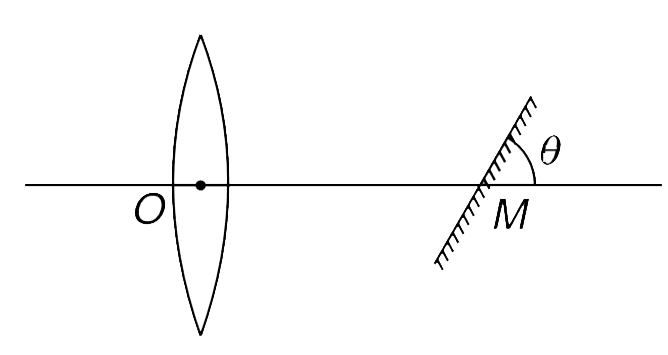A system consists of a thin symmetrical converging glass lens with the curvature radius of its surfcaes R=38cm and a plane mirror oriented at right angles to the optical axis of the lens. What is the optical power of this system when the space between the lens and the mirror is filed up with water ?
The plane mirror forms the image of the lens, and water, filled in the space between the two, behind the mirror, as shown in the figure.
So, the whole optical system is equivalent to two similar lenses, seperated by a distance 2l and thus, the power of this system,
Φ=Φ1+Φ2−dΦ1Φ2n0, where Φ1=Φ2=Φ'1
= optical power of individual lens and n0=R.I. of water.
Now, Φ'= optical power of first convex surface + optical power of second concave surface.
=(n−1)R+n0−nR,n is the refractive index of glass.
(2n−n01)R...........(1)
and so, the optical of whole system
Φ=2Φ'−2dΦ'2n0=3.0D, substituting the values.

Topper's Solved these Questions
- OPTICSBOOK - IE IRODOV, LA SENA & SS KROTOVCHAPTER - OPTICSEXERCISE - Interference Of Light
33 Videos
- OPTICSBOOK - IE IRODOV, LA SENA & SS KROTOVCHAPTER - OPTICSEXERCISE - Diffraction Of Light
60 Videos
- MECHANICSBOOK - IE IRODOV, LA SENA & SS KROTOVCHAPTER - MECHANICSEXERCISE - Mechanics Problems
92 Videos
- OSCILLATIONS AND WAVESBOOK - IE IRODOV, LA SENA & SS KROTOVCHAPTER - OSCILLATIONS AND WAVESEXERCISE - Electromagnetic Waves, Radiation
36 Videos
Similar Questions
Find the positions of the perinciple planes, the focal and model points of a thin biconvex symmetric glass lens with curvature radius of its surfaces equal to R=7.50cm. There is air on one side of the lens and water on the other.
View SolutionTwo identical thick symmetrical biconvex lenses are put close together. The thickness of each equals the curvature radius of its surfaces, i.e d=R=3.0cm. Find the optical power of this system in air.
View Solution
Knowledge Check
Behind a thin converging lens having both the surfaces of the same radius 10cm, a plane mirror has been placed. The image of an object at a distance of 40 cm from the lens is formed at the same position. What is the refractive index of the lens?
 A1.5B5/3C9/8DNone of these
A1.5B5/3C9/8DNone of theseAn optical system consists of a thin convex lens of focal length 30cm and a plane mirror placed 15cm behind the lens. An object is placed 15cm in front of the lens. The distance of the final image from the object is
A60cmB30cmC75cmD45cm
In figure , L is half part of an equiconvex glass lens (μ=1.5) whose surfaces have radius of curvature R =40cm and its right surface is silvered . Normal to its principal axis a plane mirror M is placed on right of the lens . Distance between lens L and mirror M is b. A small object O is placed on left of the lens such that there is no parallax between final images formed by the lens and mirror. If transverse length of final image formed by lens is twice that of image formed by the mirror , calculate distance'a' in cm between lens and object.
_S01_072_Q01.png)
View SolutionThere is a thin symmetric bi-convex lens with radius of curvature for its surface to be 40 cm. One surface of the lens is silvered to make it reflecting from inner side. What will be the focal length of equivalent concave mirror?
View SolutionA horizontal parallel beam of light passes though a vertical convex lens of focal length 40 cm. Behind the lens there is a plane mirror making an angle θ with the principal axis of the lens. The mirror intersects the principal axis at M. Distance between the optical centre of the lens and point M is OM=20cm. The light beam reflected by the mirror converges at a point P. Distance OP is 20 cm. Find θ.

View SolutionAn object of height 4 cm is kept to the left of and on the axis of a converging lens offocal length 10cm at a distance of 15cm from lens. A plane mirror is placed inclined at 45∘ to the lens axis, 10 cm to the right of the lens.Find the position and size of the image formed by the lens and mirror combination. Trace the path ofthe rays forming the image.
View SolutionTwo identical thin converging lenses brought in contact so that their axes coincides are placed 12.5cm form an object. What is the optical power of the system and each lens, if the real image formed by the system of lenses if four times as large as the object?
View SolutionA convex lens is placed in contact with a plane mirror. An axial point object at a distance of 20cm from this combination, has its image coinciding with itself. What is the focal length of the convex lens ?
View Solution
